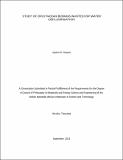| dc.contributor.author | Wagutu, Agatha W. | |
| dc.date.accessioned | 2019-05-31T08:40:05Z | |
| dc.date.available | 2019-05-31T08:40:05Z | |
| dc.date.issued | 2018-09 | |
| dc.identifier.uri | https://doi.org/10.58694/20.500.12479/286 | |
| dc.description | A Dissertation Submitted in Partial Fulfillment of the Requirements for the Degree of Doctor of Philosophy in Materials and Energy Science and Engineering of the Nelson Mandela African Institution of Science and Technology | en_US |
| dc.description.abstract | High levels of fluoride (F-) in community drinking water supply is recognized as one of the major public health problems. Until now no efficient and affordable F- removal technology exists in many regions. This research explored crustacean biomass waste for development of adsorbent for F- removal. Chitin and calcium carbonate components in crabs and prawns shells were selected for development of three adsorbents: chitosan, calcium phosphate systems (CAPs) and composite of chitosan and CAPs. All the adsorbents were characterized using XRD and FT-IR. Chitosan was obtained by deacetylation of chitin and then modified by cross-linking with glutaraldehyde and protonated using hydrochloric acid. Interaction of F- with the modified chitosan was studied using batch adsorption test and theoretical Density Function Theory (DFT) calculations. Results indicated that computed parameters matched well with experimental results and confirmed that electropositivity of hydrogen atoms influenced F- adsorption by electrostatic attraction. Best performance was achieved in low F- polluted water (≤ 5 mg/l) with adsorption capacity 1.6 mg/g. Calcium recovered from demineralization of shells was precipitated into CAPs using ammonium dihyhrogen phosphate. Crab shell produced dicalcium phosphate dehydrate or brushite (CaHPO4.2H2O) while prawns shell gave hydroxyapatite (Ca5(PO4)6.(OH)2) form of CAPs. Brushite was more effective in F- adsorption with efficiencies above 92% and highest capacity of 13.6 mg/g in field water with fluoride concentration of 5-70 mg/l compared to prawns shell hydroxyapatite with capacity of 8.5 mg/g. FT-IR analysis and kinetic studies predicted defluoridation occurred by ion exchange and ion adsorption mechanisms, described by pseudo 2nd order kinetics. Failure to remove microbes was identified as limitations of the CAPs. Composite of chitosan and brushite was thus developed to address the problem. Analysis with XRD and FT-IR confirmed transformation of brushite phases into hydroxyapatite and formation hybrid composite. Highest F- adsorption efficiency (88%) was achieved for water with F- ≤ 10 mg/l. Microbial count significantly reduced in treated water and final pH was within the acceptable range of 6-9. Adsorbate–absorbent interaction was best described by pseudo 2nd order kinetics. | en_US |
| dc.language.iso | en_US | en_US |
| dc.publisher | NM-AIST | en_US |
| dc.subject | Research Subject Categories::FORESTRY, AGRICULTURAL SCIENCES and LANDSCAPE PLANNING | en_US |
| dc.title | Study of crustacean biomass wastes for water defluoridation | en_US |
| dc.type | Thesis | en_US |

